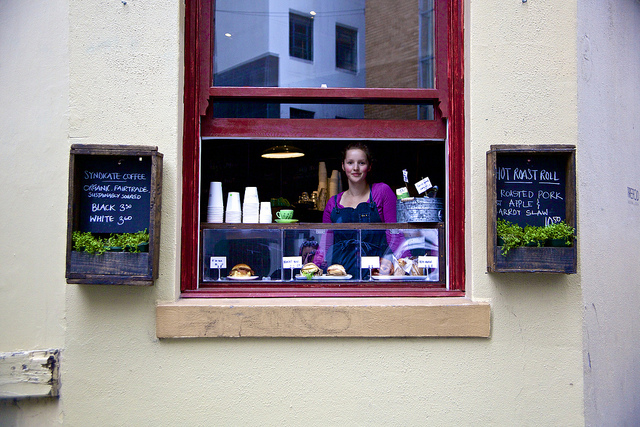Unlock the Magic in Your Story Now
Get the Free 20 questions to Ask Before Launching Your Idea workbook when you sign up for occasional updates.
Get the Free 20 questions to Ask Before Launching Your Idea workbook when you sign up for occasional updates.
Articles filed in: Strategy
How To Stay True To Your Brand Story
filed in Storytelling, Strategy
 You can spot the best restaurant on Melbourne’s Bourke Street a mile away. It’s the one with fresh flowers on the tables outside and the gleaming windows. If you’re there early enough, you’ll see a professional window cleaner meticulously washing and polishing the glass every other morning, long before the first groggy coffee order is placed at 7.
You can spot the best restaurant on Melbourne’s Bourke Street a mile away. It’s the one with fresh flowers on the tables outside and the gleaming windows. If you’re there early enough, you’ll see a professional window cleaner meticulously washing and polishing the glass every other morning, long before the first groggy coffee order is placed at 7.
Story-driven brands pass every decision and subsequent action through a filter. Their story is lived, not just told. Being story-driven is less about following brand guidelines and more about choosing to act in alignment. We’ve recently witnessed how a company’s purpose and values manifest in the actions of its employees when a passenger was dragged from a United Airlines flight to accommodate members of staff. United’s customer commitment (the company doesn’t seem to have a mission statement) says:
“We are committed to providing a level of service to our customers that makes us a leader in the airline industry. We understand that to do this, we need to have a product we are proud of and employees who like coming to work every day.”
When a business strives to be ‘the industry leader’ the bottom line tends to be its first priority. The staff were acting in alignment, as was the CEO when he issued this apology that puts the airline’s interests before customers:
“This is an upsetting event to all of us here at United. I apologize for having to re-accommodate these customers. Our team is moving with a sense of urgency to work with the authorities and conduct our own detailed review of what happened. We are also reaching out to this passenger to talk directly to him and further address and resolve this situation.”
– Oscar Munoz, CEO, United Airlines
He later released a second apology, promising to review policies and procedures—which in every organisation are created to align with the company’s purpose, vision and values. Like Mr Munoz and United, we all need to start there.
How you apologise is a choice. The expression you wear as you greet the customer is a choice. Where you source your ingredients is a choice. What you include or omit from your terms and conditions is a choice. Investment in design. Location. Customer care and spotless windows.
All choices we’re free to make—not because we have to, but because we want to.
Questioning your choices before you act helps you to stay true to your story consistently.
4 Alignment Questions For Story-Driven Brands
Does this represent who and what we stand for?
Does this sound like us?
Does this look like us?
Does this feel like us?
Rather than feeling overwhelmed about getting it wrong consider these decisions as deliberately placed waymarkers on the road to creating the impact you want to make. It doesn’t matter whether you’re one of the world’s biggest airlines or a one man band. In the end, it’s easier to tell and live a story that’s true.
Image by Michelle Robinson.
What’s Your Reason?
 The pressure to take part in the race to be first is real, and not just in business. We’re subtly enrolled and invested in this quest from the moment our parents start comparing our progress from cutting teeth to crawling, with that of our peers.
The pressure to take part in the race to be first is real, and not just in business. We’re subtly enrolled and invested in this quest from the moment our parents start comparing our progress from cutting teeth to crawling, with that of our peers.
Our culture associates coming first with being happier, having more freedom and an abundance of choices—but one doesn’t necessarily follow the other. Success and fulfilment don’t always go hand-in-hand, and ambition alone is not what drives accomplishment.
It’s more important to understand our motivation for taking part than it is to strive to cross the winning line first. What’s your reason?
Image by Frans Persoon.
Two Essential Characteristics Of Story-Driven Brands
filed in Storytelling, Strategy
 You’ve probably had a disappointing experience with a brand or business. Maybe you couldn’t put your finger on what was wrong or why? Customer dissatisfaction is a result of a gap between promises and actions. Filthy bathrooms at the restaurant with the elaborately embossed menu. The snappy flight attendant who wears a painted on smile. Uncomfortable plastic seats in the chiropractor’s waiting room. Out of date produce on sale in the organic grocery store. A damaged delivery that was carelessly packaged.
You’ve probably had a disappointing experience with a brand or business. Maybe you couldn’t put your finger on what was wrong or why? Customer dissatisfaction is a result of a gap between promises and actions. Filthy bathrooms at the restaurant with the elaborately embossed menu. The snappy flight attendant who wears a painted on smile. Uncomfortable plastic seats in the chiropractor’s waiting room. Out of date produce on sale in the organic grocery store. A damaged delivery that was carelessly packaged.
People often ask me about the secret of a great brand story. I think there are two. Truth and consistency. It’s hard to live one without the other. When our brands are story-driven, that story is lived in every single decision, consistently, on good days and bad. The delight is in the detail.
Image by Dukas Ju.
Difference By Design
 Yesterday I was registering a domain name online when I noticed the company had tweaked the user interface from cart to checkout. Now when you confirm the purchase, the default option is to register for three years, instead of one. The steps to reverse this are not obvious or easy—which I guess means sales are up by 66%—especially with new or inexperienced customers.
Yesterday I was registering a domain name online when I noticed the company had tweaked the user interface from cart to checkout. Now when you confirm the purchase, the default option is to register for three years, instead of one. The steps to reverse this are not obvious or easy—which I guess means sales are up by 66%—especially with new or inexperienced customers.
I’m left trying to imagine the meeting where the head of the business development thought this was an excellent growth strategy and a software engineer implemented the change against her better judgement. Would they consider it acceptable if a sales assistant at a bricks and mortar store tripled their father’s bill by adding two additional items to his basket without permission—just because they could?
The data is clearly telling the company they’re winning, but at what cost? We make a difference by design, not by default—when we put our hand on our heart and question whether this is the right thing to do.
*Note: Since I (and no doubt other customers) drew this to the company’s attention they have rectified the situation. They also denied ever having defaults for domain registrations unless required by the Registry, because this would prohibit them from functioning as a Registrar. Again this goes back to the earlier point. Integrity doesn’t require rules.
Image by David Joyce.
The Easy Part Of Marketing
 The easy part of marketing is working out what to say, when and where, to whom, in order to sell what we make. We expend most of our energy on the easy part.
The easy part of marketing is working out what to say, when and where, to whom, in order to sell what we make. We expend most of our energy on the easy part.
The hard part is understanding why it’s important to say what we’re about to say and who will care enough to listen. We should start with the hard part.
Image by sharkhats.
Less But Better
 In the bygone era of local shopping strips lined with family owned businesses the job of each business wasn’t simply to make a profit—it was to add value to the community it served. Every business had a purpose beyond the single bottom line. Every transaction, from a pint of milk to five screws wrapped tightly in brown paper, mattered. Paradoxically it was the care the owners took with the smallest order that helped them to thrive for longer than the big chain stores might have predicted.
In the bygone era of local shopping strips lined with family owned businesses the job of each business wasn’t simply to make a profit—it was to add value to the community it served. Every business had a purpose beyond the single bottom line. Every transaction, from a pint of milk to five screws wrapped tightly in brown paper, mattered. Paradoxically it was the care the owners took with the smallest order that helped them to thrive for longer than the big chain stores might have predicted.
We’ve come to believe that people always want more or that they invariably choose the fast and easy option. This isn’t true of every customer. What if instead of trying to deliver more, faster to everyone we strived to do less but better for fewer?
Image by John Weiss.
The Simple (Not Easy) Strategy For Business Growth
 When we think about business development opportunities, we mostly begin by knowing exactly where we are today and what goals we want to reach next. From there we set out to widen our net and acquire more customers or users for our existing products and services. Our growth strategy starts with the need to expand our customer base in pursuit of the targets we set.
When we think about business development opportunities, we mostly begin by knowing exactly where we are today and what goals we want to reach next. From there we set out to widen our net and acquire more customers or users for our existing products and services. Our growth strategy starts with the need to expand our customer base in pursuit of the targets we set.
If Steve Jobs had stuck with only this kind growth strategy, the iPhone wouldn’t exist. What he did instead of simply casting the net wider was connect the dots between Apple’s capabilities and where the customer would want to go next—even before the customer knew himself.
Net widening is a fine growth strategy, but it’s also one your competitors are likely adopting—which means whoever gets new customers faster (perhaps by being cheaper) will come out on top. There is an alternative.
We can create long-term value for our companies by understanding where the customer is today and where they want to go next. The path to growth doesn’t always mean having a bigger net. Often it’s about taking the time to consider if a net is the best tool for the job.
Image by Hasin Hayder.
More Vs. Deeper
 On the surface of it, the all-you-can-eat buffet seems like a generous bargain. Why is it then that we walk away having had our fill without feeling satisfied? The truth is we know that far from being generous the offer of ‘more’ is a tactic to get the most people through the door. We understand the restaurant owner is hoping we come with small appetites and leave early.
On the surface of it, the all-you-can-eat buffet seems like a generous bargain. Why is it then that we walk away having had our fill without feeling satisfied? The truth is we know that far from being generous the offer of ‘more’ is a tactic to get the most people through the door. We understand the restaurant owner is hoping we come with small appetites and leave early.
Contrast the all-you-can-eat experience with that of the performer who must somehow find a way to deliver value to a stadium of 75,000 fans, most of whom she can’t reach or look in the eye. Singing one more song at the end of her set is unlikely to create the connection she hopes to make with each person. Her only option is to find ways to go deeper.
So she shares intimate stories of her journey from support act to superstar. She acknowledges the unique attributes of the city she’s performing in. She displays unpublished images from her childhood on the big screen. And she makes tiny handwritten love notes that are photocopied and turned into a mid-performance shower of confetti—souvenirs for her fans to keep.
We mistakenly believe that value creation is about delivering more for less when in many cases what delights our customers is more of less.
How can you give more by going deeper?
Image by Jackson Lavarnway.
Why You Need To Build A Story-Driven Business
filed in Storytelling, Strategy
 What drives our desire to get better at telling the story of our products, services and companies? We’re used to thinking of story as a way to create and communicate value. We know the running shoe with a tick on the side is more valuable than the one without because of the expectations and meaning we have attached to the story of the Nike brand. And who doesn’t want their company to be more meaningful and valuable?
What drives our desire to get better at telling the story of our products, services and companies? We’re used to thinking of story as a way to create and communicate value. We know the running shoe with a tick on the side is more valuable than the one without because of the expectations and meaning we have attached to the story of the Nike brand. And who doesn’t want their company to be more meaningful and valuable?
What we really want from our story, though, goes beyond the need to be better known, sell more stuff or make more money. We are yearning for a deeper understanding of what we’re here to do and the difference it might be possible to create. The story, not of what is, but what’s at stake and what could be is what drives our desire to succeed.
The most inspired entrepreneurs and successful organisations know how important and powerful understanding the significance of your story can be. What drives Elon Musk, for example, is not building more cars for the sake of selling more cars. Tesla Motors and SolarCity (the energy company Musk is Chairman of) exist to ‘accelerate the advent of sustainable energy’.
If someone were to ask you to tell them the story of your business you’d likely explain what you make, who you serve, where and how long you’ve been doing it. It’s unlikely you’d begin by telling them why any of it matters in the grand scheme of things (even though it does). What’s at the heart of your story? What’s the reason you got out of bed this morning? It isn’t just pride in the product you made, the need to launch the website you coded or the hope of selling the service you designed. It’s the deep desire to change someone or something you care about changing and the belief that it’s possible.
The intended impact of your work on the world and in the lives of the people it touches is where your story begins.
Elon Musk knows what he’s setting out to do over the next ten years because he and his companies are built on a story-driven business framework. Their vision of a sustainable energy economy which helps to avert the collapse of civilisation is the reason they are setting out to;
‘Create stunning solar roofs with integrated battery storage, expand the electric vehicle product line to address all major segments, develop a self-driving capability that is 10X safer than manual and enable your car to make money for you when you aren’t using it.’
THE STORY-DRIVEN BUSINESS FRAMEWORK
1. PURPOSE: Why we exist.
2. VISION: Where we’re headed.
3. VALUES: The beliefs that guide us on that journey.
4. PLAN: How we will deliver on the vision while staying true to our values.
When your business or organisation is story-driven, it’s grounded in a framework of purpose, vision and values that inspire commitment, create momentum and lead to a solid plan for achieving success. This enables you to adapt in times of change because you understand that your story is bigger than the scene that’s playing out in the moment.
What’s driving your story?
Image by NRMA
You WILL Have Unhappy Customers
filed in Storytelling, Strategy
 Unhappy customers are a bit of an Achilles heel of the committed entrepreneur, business owner or leader. When you’re working hard to build a business and do meaningful work the last thing you want to hear is that you haven’t met the mark. You can find thousands of practical, stay calm, listen, sympathise, don’t take it personally and solve the problem type articles and advice online. But skillfully dealing with the complaint isn’t the hard part. The more challenging thing to cope with and attend to is our visceral reaction to criticism.
Unhappy customers are a bit of an Achilles heel of the committed entrepreneur, business owner or leader. When you’re working hard to build a business and do meaningful work the last thing you want to hear is that you haven’t met the mark. You can find thousands of practical, stay calm, listen, sympathise, don’t take it personally and solve the problem type articles and advice online. But skillfully dealing with the complaint isn’t the hard part. The more challenging thing to cope with and attend to is our visceral reaction to criticism.
The unhappy customer lays his story at our feet, and we hastily pick it up, place it on our shoulders and carry it around with us. Yes, sometimes our products or services fall short, sometimes we get it wrong even when we’re doing our best. We should always apologise for failing to meet expectations and do what we can to resolve the problem. What we must also do is recognise that often the customer’s fear, anger, remorse or disappointment has less to do with a bad experience and more to do with what’s going on in his life right now.
You WILL have unhappy customers, no matter how caring and diligent you are. There is no way to avoid the pain of this fact. That one in a hundred customer who calls you out is the price you pay for the privilege of getting up to do the work again another day.
So yes, take responsibility for your mistakes and fix the things you can fix—while remembering there are some things you have no way of making good. You are not obliged to own the weight of your customer’s circumstances or worldview. You have an obligation to get back on track for the other ninety-nine customers you hope to serve and delight. Some of the greatest lessons unhappy customers can teach us are not about improving systems, processes and logistics, which in the end are easily fixed. The important learnings are about ourselves, and our resilience and determination to do good work and make a difference to the people we get the chance to serve again tomorrow and the day after that.
Image by FFCU.